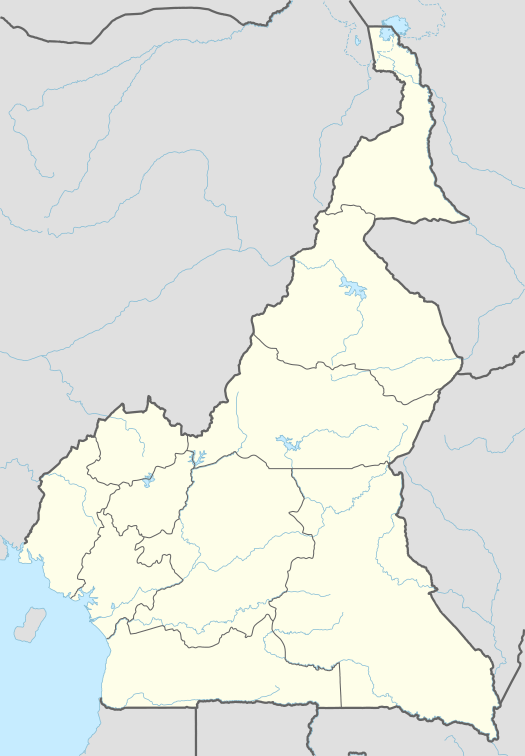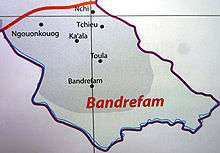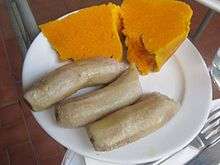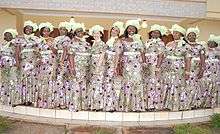Bandrefam
| Bandrefam Ndiògfap | |
|---|---|
| Commune and town | |
 Bandrefam Location in Cameroon | |
| Coordinates: CM 5°13′N 10°29′E / 5.217°N 10.483°E | |
| Country |
|
| Region | West Region |
| Department | Koung-Khi |
| Area | |
| • Total | 7 sq mi (17 km2) |
| Population | |
| • Total | 5,000 |
| Time zone | WAT (UTC+1) |

The Bandefram-Cameroon Chiefdom. Pronounced Ndiògfap in local language, this name means farmers of old vineyards. Although Bandrefam is the official name, the population of this chiefdom call themselves Kouo'shi, which means : emerging from the ground.
The Kouo'shi are Bamiléké people (Semi-Bantu) who are descended from several generations of migrants from North Cameroon and whose origins could be traced back to Egypt during Pharaohs’ time.
Bandrefam is located about 300 km from Douala the commercial capital of Cameroon, about 300 km of Yaounde the political capital and 25 km from Bafoussam, the regional capital.
At the administrative level, it is part of the Bayangam commune, in the department of Koung-Khi in the West province of Cameroon. The kingdom is directed by His Majesty Jiejip Pouokap.
_et_Batoufam.jpg)

History
Bandrefam is a several-century-old kingdom. It was founded between the 12th and 13th century. It is one of the oldest kingdoms in the Bamiléké region. Because of inheritance quarrels between sons, this kingdom split up, leading to the creation of the chiefdoms Bangoua, Batoufam and Babouantou.
During the previous centuries, Bandrefam suffered from numerous attacks from its neighbors. The most recent one is the nine-year war against the Bangoua chiefdom. This fratricidal war ended with the signing of a peace treaty (Pact of reconciliation and forgiveness) between the two chiefdoms on September 30, 2006.
During the years of war, before and after the independence of Cameroon, Bandrefam got annihilated, like many other Bamiléké chiefdoms, by Ahidjo’s repressive regime, backed by the French army.(see Bamiléké genocide[1][2][3][4] ). This repressive violence contributed to a significant destruction of the population by tens of thousands. The majority of the survivors were forced to go into exile. Most of them never came back.
Geography
Bordered on the West and South-West by Bangoua, on the North by Batoufam and on the East by Bagang-Fokam, Bandrefam covers an area of about 17 square km divided in six districts : Ngouonkouong, Nka’ala, Pou’guieu, Tchieu, Toula et Ntchi.
Its relief is formed by plateaus (Lô’oshitô, Tchî, Sinkouô) and mountains (Kouofiog, Kouomenang) interspersed with fertile valleys rich in fine sand.
Panchêh and Wooze are the main rivers running through the village.
The climate is tropical, characterized by a long dry season and a short rainy season.
Population
The population of Bandrefam, relatively consistent, is estimated today at about five thousand (5000) inhabitants living in the kingdom’s area.
During harvesting time and funerals this population can at least double, because of relatives visiting temporarily from outside the kingdom.
Language
Bandrefam is also a language and is part of the Bantu languages group, which in turn is part of the gigantic Niger–Congo languages family.
Religion
Kouo'shi people are usually attached to ancestral practices : the cult of the dead. A minority is either christian or animist. Some churches got built, the main ones being the chapel of the Catholic Church and the parish of the Evangelistic Church of Cameroon.
Economy
Subsistence farming, small livestock farming and handicraft are the main sources of income of the population.
They generally grow peanuts, corn, potatoes, yam, manioc, plantain bananas but also small exploitations of substinence crops such as tomatoes, cabbage, watermelons, etc.

They breed goats, sheep, and poultry for commercial purposes.
Farming Arabica coffee is also part of the agricultural activities.
Funerals is another significant commercial activity that create temporary jobs for unemployed people.
Bandrefam has a local market where villagers go to sell their products.
Education
The school system of Bandrefam is completely public and depends on the Ministry of Education, regional commission of the West. It is made up of a nursery school, an elementary school, a secondary school of technical and commercial education (CETIC). There is also, at about four kilometers (in Kamna, in the village Bangoua) a general education high school for students who wish to pursue their education.
Health
Bandrefam has an integrated health center where patients can receive first-aid. More serious cases are transferred to the Bafoussam regional hospital.
Tourism and points of attraction

Visitors coming from Douala and entering from the South (through Kamna market) will have the chance to discover, from Lô’oshitô hill, a lush scenery in the valley, the full-size Bandrefam with its scattered houses made of soil bricks with conical straw roofs.
Tourists will also see in the distance the green pasture land of Serkouò, interspersed with small cavernous rocky mountains, located about 3 km from the chiefdom.
The archeological site of Kùog fiòg, made up of several blocks of granite carved several centuries ago, located about 2 km away from the chiefdom, and the last remains of the Bana-Foumban road built by the Germans are other points of interest for tourists.
Infrastructure
The Bandrefam chiefdom is accessible by land. It is located not very far (about 4 km) from the national road number 4, connecting Yaoundé, the political capital of Cameroon and Bafoussam, the regional capital of the West.
It is crossed, from East to West, by the secondary road (D63) that connects Batié to Bagang- Fokam, via Bandenkop and Bangou. Some sections of this road are sealed but the stretch between national road 4 and Bandrefam is not sealed.
From Kamna market or from the Bayangam toll (on national road 4), visitors can take a cab or a motorbike taxi until the village.
Cuisine
Koki with poyo banana, corn couscous with Nkùir, bean fritter with manioc stick, pistachio or peanut dish with manioc stick, plantain mixed with goat or beef meat (the dish is called Nkòndrè), taro with yellow sauce, crushed potatoes and black beans, form a typical popular menu. All this can be served with a palm or raffia wine.



Dance and music
Méndoù and Methièu are the main dances usually performed during big ceremonies. Méndoù is a men’s dance, performed in a circle in the center of which the drum rolls and the balafon cadenced by the dancers’ songs make up the main symphony. It is usually a languid and sorrowful rhythm, probably as a reminder of the sad and painful memories from the past centuries. The white gandoura and the chéchia make up the dance uniform that offers an exuberant spectacle. Methièu is a women’s dance, also performed in a circle in the center of which the lead singer gives the rhythm with her voice and her dance steps. All the other dancers join in unison. The dancers wear flowery loincloths and a small jingle bell around the ankle, the only musical instrument of the dance. With coordinated steps, these jingle bells make a harmonious tinkling sound, making the choreography very pleasant to watch. Here, the rhythm is more lively and cheerful. The songs are usually in honor of the dignitaries, children and benefactors of the kingdom. Women also sing the love of their fellows and peace between people.
Life and Society

Sons and daughters native of Bandrefam but living outside the Kingdom gather in associations to join their efforts in order to help the development of their locality. Development Comity of Bandrefam (CODEBA), and the association AGIR are two examples.
Media and Communication
The kingdom receives TV and radio signals from the surrounding area.
CRTV and Canal 2 international are the main TV channels. Some homes also receive foreign channels thanks to satellite dishes.
FM 94, CRTV national radio, CRTV West region, Radio Venus, and Radio Batcham are broadcast in Bandrefam.
Cameroon Tribune, Ouest Echos, Le Messager, Mutations, Nouvelle Expression and Le Jour are the main newspapers from Bafoussam.
Telephone/Internet
Bandrefam is covered by mobile phone networks such as MTN and Orange.
Internet is only available on mobile phones through the operators MTN and Orange. Visitors must go to Bafoussam (25 km away)to browse the web.
Notable people from Bandrefam
Mr Samuel Tchangoum, Businessman, CEO of Serena Hotels and of the Aston Satellite group.
Mr Charles Tchoungang, Lawyer recognized by the Cameroon bar.
Elvis Kemayo, Musician and former Cameroon Radio-Television celebrity.
References
- ↑ http://www.brukmer.be/2012/05/17/le-genocide-camerounais-par-larmee-francaise-video
- ↑ http://www.bamileke.org/Newfolder/genocide.htm
- ↑ Owono, Julie (25 January 2012) http://www.aljazeera.com/indepth/opinion/2012/01/201211871746225899.html
- ↑ Toukam, Dieudonné (2010). Histoire et anthropologie du peuple bamiléké. Paris: l’Harmattan.
External links
- Official Website
- World Weather Online
- Bandrefam on Tageo
- http://www.forafricanart.com/Bamileke_ep_38-1.html